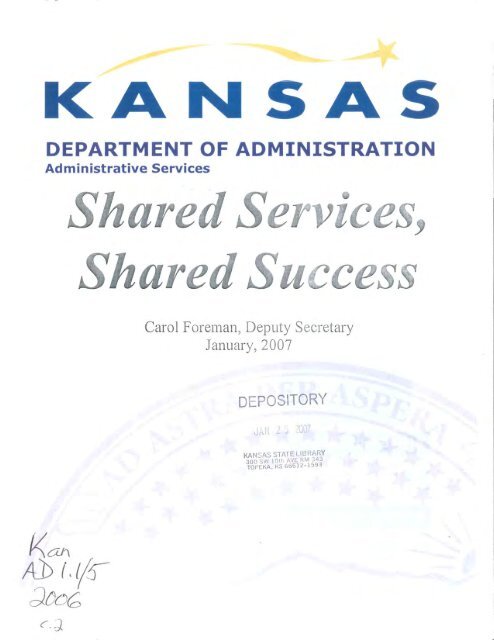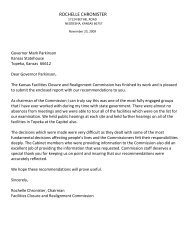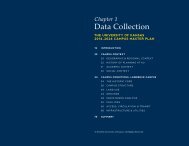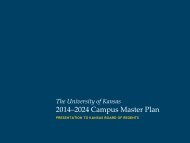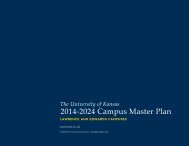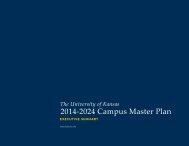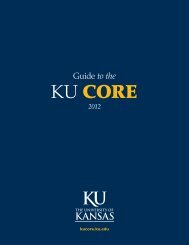Kansas Department of Administration 2006 Annual Report.pdf
Create successful ePaper yourself
Turn your PDF publications into a flip-book with our unique Google optimized e-Paper software.
~<br />
KANSAS<br />
DEPARTMENT OF ADMINISTRATION<br />
Administrative Services<br />
Carol Foren1an, Deputy Secretary<br />
January, 2007<br />
OEPOSlTORY<br />
KA NSAS STATE LIBRARY<br />
3 0 0 SW 10tt AVE RM 343<br />
TOPEKA. KS 66612- 1593<br />
I< CUI<br />
A:b r.r;sdoCJ~<br />
c-.]
~ -----...._ __.<br />
KANSAS<br />
DEPARTMENT OF ADMINISTRATION<br />
-<br />
Organization~l Ctiar.t f..o<br />
<strong>Department</strong> Qf: Admini<br />
I<br />
Administrative<br />
Services<br />
Carol Foreman,<br />
Deputy Seuclary<br />
I<br />
Di visions<br />
- '·<br />
' \<br />
Secretary's Office<br />
Personne l Services<br />
Accounts and Rep orts<br />
Facilities Management<br />
Purchases<br />
Printing and Su rpl us Property<br />
Legal<br />
Ad ministrative Hear ings<br />
\ Long Term Care Ombudsman 1<br />
1<br />
<strong>Department</strong> <strong>of</strong><br />
Admin is tra t ion<br />
Duane Gooss en,<br />
Secretary<br />
I<br />
Divisio n <strong>of</strong>the<br />
Budget<br />
Duane Goossen,<br />
Director<br />
I<br />
I<br />
I<br />
r<br />
\.<br />
I<br />
'<br />
I nformation<br />
Systems and<br />
Communications<br />
(DISC)<br />
Denise Moore,<br />
Director<br />
~<br />
Administ rative Services<br />
Division <strong>of</strong> the Budget<br />
DISC<br />
445<br />
18<br />
180<br />
Administrative Services<br />
<strong>Department</strong> <strong>of</strong> <strong>Administration</strong><br />
$60,804,697<br />
$107,013,908<br />
2
Shared Services, Shared Success<br />
<strong>Kansas</strong> <strong>Department</strong> <strong>of</strong> Aclmin istr
While there are eleven total divisions within the <strong>Department</strong> <strong>of</strong> <strong>Administration</strong>, five are<br />
most intimately involved with other agencies within the State <strong>of</strong><strong>Kansas</strong> and are the key<br />
divisions for implementing the D <strong>of</strong> A vision. These five divisions make up the majority <strong>of</strong><br />
the administrative services section.<br />
The <strong>Department</strong> <strong>of</strong> <strong>Administration</strong> had long been known as a provider <strong>of</strong> services, and in<br />
some cases the controller <strong>of</strong> those services, unilaterally making the decisions on who, what,<br />
where, when, and how.<br />
As previous reports have highlighted, the new relationship with the State <strong>of</strong><strong>Kansas</strong> is one<br />
<strong>of</strong> collaboration and cooperation. This relationship is the heart <strong>of</strong> our shared services<br />
philosophy. The <strong>Department</strong> has identified its core functions, how those core functions<br />
can serve the State <strong>of</strong> <strong>Kansas</strong> as an enterprise, and reached out to our customers, no matter<br />
the size, to determine how best to deliver those core functions.<br />
FACILITIES<br />
• Leasing Shared<br />
• Services Team<br />
• Joint Tenants<br />
Meetings<br />
• Capitol Complex Plan<br />
PRINTING & SURPLUS<br />
Brand Image Campaign<br />
Consolidate Central Mail<br />
Improved Business<br />
Practices<br />
Collaborative Relationships<br />
PRIMARY FUNCTIONS<br />
~Facilities<br />
~Printing & Surplus<br />
~Purchasing<br />
~Personnel<br />
~Accounts & <strong>Report</strong>s<br />
PURCHASING<br />
Procurement Negotiating<br />
Committees<br />
Contract Development<br />
Meetings<br />
Statewide Contracts<br />
PERSONNEL<br />
Statewide Human<br />
Resources Meetings<br />
Job Classification Review<br />
Regulation Review<br />
Pay Plan Study<br />
ACCOUNTS &<br />
REPORTS<br />
Financial Management<br />
System<br />
Policy/Procedure Manual<br />
Review<br />
Rather than diminishing the authority <strong>of</strong> the <strong>Department</strong> <strong>of</strong> <strong>Administration</strong>, this shared<br />
services model has greatly enhanced our role.<br />
4
The D <strong>of</strong> A values, "Character, Commitment, Communication,<br />
and Credibility," are keys to this change. One <strong>of</strong> the ways the<br />
<strong>Department</strong> Leadership Team chose to put those values into<br />
action was by changing the way they interacted with ASTRA, the<br />
Agency STARS Rapport Association.<br />
ASTRA provides a forum for state agencies to discuss statewide<br />
financial management issues, as well as other issues which touch<br />
on the management <strong>of</strong> state agencies, including purchasing,<br />
facilities, and personnel.<br />
Since its inception in 1991, the divisions <strong>of</strong> D <strong>of</strong> A have appeared<br />
before ASTRA individually, <strong>of</strong>ten spread out across a day long<br />
agenda. For instance, in February, <strong>2006</strong>, the Division <strong>of</strong><br />
Facilities Management appeared first on the agenda, while the<br />
Division <strong>of</strong> Purchases did not appear until the end <strong>of</strong> the day.<br />
At the next meeting in May, however, the <strong>Department</strong> <strong>of</strong> <strong>Administration</strong> appeared as a<br />
team. This not only eliminated the past problems involving questions from participants not<br />
receiving complete answers from individual Directors, it also presented D <strong>of</strong> A as an<br />
agency, rather than a collection <strong>of</strong> Divisions.<br />
While this change may seem minor, it demonstrates the deep commitment D <strong>of</strong> A has to<br />
breaking down barriers not only between the <strong>Department</strong> and other agencies, but between<br />
individual divisions. Shared Services means each division works together, and decisions<br />
don't just reflect the character or credibility <strong>of</strong> Personnel Services or Accounts & <strong>Report</strong>s,<br />
but <strong>of</strong> the <strong>Department</strong> <strong>of</strong> <strong>Administration</strong>.<br />
The process, described in previous annual reports, which began with individual divisions<br />
making decisions in full communication with their customers, has become a part <strong>of</strong> the D<br />
<strong>of</strong> A culture. Now, it is not divisions communicating with<br />
agencies or making decisions on how best to deliver<br />
services, it is the <strong>Department</strong> <strong>of</strong> <strong>Administration</strong> as a<br />
whole.<br />
As the decision making process has grown to touch all<br />
divisions, <strong>Department</strong> <strong>of</strong> <strong>Administration</strong> employees have<br />
seen their roles change, expanding to meet the new<br />
challenges <strong>of</strong>working across agencies.<br />
In <strong>2006</strong>, the <strong>Department</strong> Leadership Team made the<br />
decision to direct more focus onto D <strong>of</strong> A employees.<br />
The change to a shared services organization, which had<br />
been going on for three years, had meant several jobs<br />
were vastly different from 2002. Making sure<br />
<strong>Department</strong> employees understood the new vision and<br />
were reflecting the <strong>Department</strong>'s values was a key part <strong>of</strong><br />
<strong>2006</strong>.<br />
5
Several major projects occurred in <strong>2006</strong>, all <strong>of</strong> which<br />
were directed internally to <strong>Department</strong> <strong>of</strong><br />
<strong>Administration</strong> staff. The goal <strong>of</strong> each effort was to<br />
reaffrim to the <strong>Department</strong> that a change had happened,<br />
but that the value <strong>of</strong> <strong>Department</strong> <strong>of</strong> <strong>Administration</strong> staff<br />
had not diminished.<br />
The first outreach to employees came in the form <strong>of</strong><br />
Resepect in the Workplace Training sessions.<br />
:1.<br />
The Diversity Committee, now known as the Workplace<br />
Respect Team, is made up <strong>of</strong> employees from each<br />
division and was put together to reach out to D <strong>of</strong> A<br />
employees not only to teach them about diversity, but to<br />
listen to their concerns about their workplace<br />
enviromnent.<br />
The Workplace Respect Team arranged for the Respect<br />
in the Workplace Training sessions, which were held in<br />
the first few months <strong>of</strong><strong>2006</strong>. Each Administrative<br />
Services employee attended a two-hour session which<br />
included presentations, two shmi videos, and<br />
small group discussion on the topics <strong>of</strong> respect<br />
and diversity. Each training session had 20-25<br />
employees and five employee trainers, from<br />
different divisions, giving participants an<br />
opportunity to meet employees from different<br />
divisions. Part <strong>of</strong> the success was due to the<br />
training being developed by the team itself.<br />
This combining <strong>of</strong> Divisions was well-received,<br />
and feedback fi·om the sessions led the<br />
committee to sponsor the planning <strong>of</strong> an allemployee<br />
appreciation picnic, held on the<br />
statehouse grounds, featuring a picnic lunch,<br />
decorations and games, and music presented in<br />
part by our own employees. This winter, as<br />
series <strong>of</strong> open houses, sponsored by each<br />
Division, will give employees an opportunity to<br />
visit other work areas and learn more about the<br />
work <strong>of</strong> all Divisions.<br />
6
The first such open house was held at<br />
the Division <strong>of</strong>Printing, and was a<br />
great success. Future open houses<br />
will be held throughout 2007, with<br />
each Division taking a turn hosting<br />
employees from across<br />
Administrative Services.<br />
To gauge the effectiveness <strong>of</strong> the<br />
changes that had been put into place,<br />
as well as to measure how engaged<br />
<strong>Department</strong> <strong>of</strong> <strong>Administration</strong><br />
employees are, the Leaderhip Team<br />
also undertook an on line survey in<br />
<strong>2006</strong>.<br />
Working with Momentum Business Group, Depmiment <strong>of</strong> <strong>Administration</strong> employees were<br />
surveyed both online and in group session about their feelings towards their work, the<br />
employers, and their fellow employees. Employees were asked about the <strong>Department</strong>'s<br />
vision and values, as well as their environment and their duties.<br />
According to the consultant, work engagement occurs when employees' values, beliefs,<br />
and goals are aligned with those <strong>of</strong> the organization such that the employee is personally<br />
cotmnitted to contributing to the accomplishment <strong>of</strong>the organization's mission. The<br />
results <strong>of</strong> the survey, as well as the analysis by Momentum Buisness Group, have been<br />
analyzed both by the Leadership Team and the managers in each division.<br />
Overall, <strong>Department</strong> <strong>of</strong> <strong>Administration</strong> staff are more engaged than the nonn, with the<br />
strongest indicators coming in the area <strong>of</strong> work ethics and strong working relationships.<br />
However, concerns such as job security and job equitywere discovered as part <strong>of</strong> the<br />
process.<br />
In 2007, the results <strong>of</strong> this survey will be used to build on the work done the past four<br />
years. Follow through on this process is essential. The <strong>Department</strong>'s vision, "The<br />
<strong>Department</strong> <strong>of</strong> <strong>Administration</strong> will lead the enterprise towards a shared services<br />
organization by modeling teamwork, cost-effective business practices, and quality<br />
customer service," will be an important part <strong>of</strong>the connection between our values and our<br />
day-to-day efforts for the State <strong>of</strong> <strong>Kansas</strong>.<br />
7
Even with all <strong>of</strong> the internal projects going on in <strong>2006</strong>, the main focus <strong>of</strong> the <strong>Department</strong><br />
continues to be serving our customers. Putting the Shared Services model into action in<br />
<strong>2006</strong> meant building on the successes <strong>of</strong>the previous three years, while also reaching out<br />
to more agencies and more customers to provide better services. Below are some<br />
highlights from the year.<br />
Reaching Out to Vets<br />
First enacted in the 19 111 Century, Veteran's Preference has long<br />
been a part <strong>of</strong>the State <strong>of</strong> <strong>Kansas</strong> hiring system. Since the<br />
enactment <strong>of</strong>the <strong>Kansas</strong> Civil Service Act in 1941, veterans <strong>of</strong><br />
the Armed Forces have been given some degree <strong>of</strong> preference in<br />
hiring. Veterans' preference laws do not guarantee the veteran a<br />
job. Preference does not have as its goal the placement <strong>of</strong> a<br />
veteran in every vacancy, but rather providing increased<br />
opportunity in recognition <strong>of</strong> the economic loss suffered by<br />
citizens who have served their country in uniform.<br />
In 1995, the State Civil Service discontinued<br />
certified rank lists <strong>of</strong> eligibles, but required "under no<br />
circumstances shall veterans be accorded any less preference than<br />
existed prior to July 1, 1995". In 2003, the Division <strong>of</strong> Personnel<br />
Services modified K.A.R. 1-6-21 regulation requiring agencies to<br />
interview all veterans who meet minimum requirements for the<br />
class. This modification to the regulations gave veterans a better<br />
opportunity to be hired into state classified civil service jobs, compared to what existed<br />
prior to 1995. In addition, it gave veterans' preference in internal agency actions such as<br />
promotion, transfer, reassignment, and reinstatement.<br />
Recent statistics indicate veterans returning from service in the Middle East had a much<br />
higher rate <strong>of</strong> unemployment than their peers. With that in mind, the Division <strong>of</strong>Personnel<br />
Services increased its efforts not only in state hiring, but in assisting veterans in fmding<br />
employment in the private sector.<br />
The Veterans Employment <strong>Report</strong> outlines these efforts. Among new initiatives are<br />
Helmets to Hardhats and Partnership for Youth Success. And, in keeping with the Shared<br />
Services model, DPS has worked very closely with the <strong>Department</strong> <strong>of</strong> Commerce in<br />
reaching out to veterans.<br />
This was also part <strong>of</strong> DPS' <strong>2006</strong> Applicant Workshops, held this fall in Topeka, Lawrence,<br />
and <strong>Kansas</strong> City. In addition, DPS has improved its e-mail outreach to applicants and<br />
employers. All told, these new services are helping Kansans find not only state jobs, but<br />
jobs in the private sector, a great example <strong>of</strong> Shared Services in action.<br />
8<br />
~ '--.!_ __ _
Finding Savings Through Shared Services: The<br />
Anatomy <strong>of</strong> a Procurement Negotiating<br />
Committee<br />
By statute, the <strong>Department</strong> <strong>of</strong> <strong>Administration</strong> has oversight over most procurement<br />
functions for the State <strong>of</strong> <strong>Kansas</strong>. While the traditional concept <strong>of</strong> state purchasing has<br />
been "low bid," the needs <strong>of</strong> a modem state government require more flexibility and<br />
greater ability to fully bring to bear the purchasing power <strong>of</strong> a large organization.<br />
The Negotiated Procurement process is based upon the concept <strong>of</strong>"Best Value" and<br />
enables agencies to consider many factors in the evaluation <strong>of</strong> bid responses beyond cost,<br />
including vendor qualifications, past performance, methodology, among others.<br />
With this additional flexibility comes additional responsibility in terms <strong>of</strong> documenting<br />
actions taken throughout the bid process, the task <strong>of</strong> evaluating technical and cost<br />
proposals, and in preparing a written justification for actions taken and award<br />
recommendations.<br />
Many <strong>of</strong> the success stories <strong>of</strong> the past four years, as documented in prior annual reports,<br />
have come to fruition thanks to usage <strong>of</strong> the Procurement Negotiating Cmrunittee (PNC).<br />
The Division <strong>of</strong> Purchases, as with standard bid documents, is always responsible for<br />
preparing a Request for Proposal (RFP). However, once the bidding process has ended, the<br />
work <strong>of</strong> the PNC begins.<br />
At bid opening, only the names <strong>of</strong> bidders are announced. The PNC then undertakes a<br />
thorough review <strong>of</strong> first the technical proposals <strong>of</strong> a bid, and then the cost proposals <strong>of</strong> a<br />
bid. After that review, one or more vendors are invited to negotiate.<br />
Negotiations will include revised <strong>of</strong>fers, as well as opportunity for discussion and Q & A.<br />
Once a review <strong>of</strong> the final <strong>of</strong>fers, both technical and cost, has been completed, a<br />
recommendation is made for award, accompanied by full documentation for that<br />
recommendation.<br />
While more complex than simply opening and determining the "best bid," the Negotiated<br />
Procurement process not only allows opportunities for lower costs, but also for better<br />
services, through the review <strong>of</strong> both the cost and technical aspects <strong>of</strong> a contract.<br />
As part <strong>of</strong> an effort in <strong>2006</strong> to fully develop the shared services model, the Division <strong>of</strong><br />
Purchases made an effort to increase personal connections with both agencies and vendors<br />
to keep costs low, improve understanding <strong>of</strong> procurement laws and practices, including the<br />
increased usage <strong>of</strong> Negotiated Procurement, and to increase understanding <strong>of</strong> D <strong>of</strong> A staff<br />
<strong>of</strong> the procurement work performed by our clients, and the impact that D <strong>of</strong> A decisions<br />
can have on those clients.<br />
A major aspect <strong>of</strong> Shared Services for the Division <strong>of</strong> Purchases has been an expansion <strong>of</strong><br />
Contract Development Meetings to reach out to clients.<br />
9
Replacing STARS: the Financial Management<br />
System (FMS) project<br />
In 200 1, the State contracted with Accenture Company to provide a report on the possible<br />
need to implement a new Financial Management System (FMS). Accenture recommended<br />
replacement <strong>of</strong>the current system, STARS, as it was nearing 15 years old and was no<br />
longer supported by a vendor.<br />
In <strong>2006</strong>, the State revisited the issue and asked Salvaggio, Teal and Associates (ST A) <strong>of</strong><br />
Austin, Texas to provide an updated Needs Assessment Study. A project team made up <strong>of</strong><br />
five representatives from D <strong>of</strong> A (three from A&R) worked with STA on the study. A<br />
Project Steering Committee was also created with representatives from 13 different<br />
agencies to oversee the progress <strong>of</strong>the study.<br />
To receive input from agencies regarding their own needs, focus groups were created.<br />
Over 200 individuals participated, representing 25 large agencies and outreach meetings 27<br />
other agency representatives who may not have taken part in the meetings. Also, system<br />
requirements were posted on the FMS project Web site for all agencies to review and<br />
provide comments.<br />
As a result <strong>of</strong> the study, ST A recommended the State pursue the acquisition and<br />
implementation <strong>of</strong> an FMS for the following reasons:<br />
• STARS is nearly 20 years old and without vendor support<br />
• Need to move from an environment that focuses primarily on processing financial<br />
transactions to one that also focuses on providing management information to<br />
policymakers for use in making critical decisions about allocating the scarce<br />
resources available for constituent programs and services<br />
• Agencies have difficulty getting meaningful and historical reports from STARS.<br />
As a result, many agencies have created "shadow systems" primarily for tracking<br />
and reporting needed information all at an additional cost to the agency<br />
• A new FMS will be Web-based and integrate all agencies regarding key financial<br />
modules, which would include Accounts Payable, General Ledger, Purchasing and<br />
Asset Management<br />
• A FMS would also replace the current procurement system (Procurement Manager<br />
Plus) and <strong>of</strong>fer "eProcurement" which would include, among other functionality,<br />
enabling State personnel to order goods/services from the negotiated State contracts<br />
by shopping via a Web browser; also would enable vendors to be notified<br />
electronically <strong>of</strong> bid opportunities for goods/services the vendor has registered with<br />
the State as providing<br />
• A FMS would also provide for a "Data Warehouse" that agencies could use to store<br />
information and create ad hoc reports for their own needs<br />
• With an integrated FMS agencies will be able to process information and<br />
transactions more quickly and with less paperwork and redundancy <strong>of</strong> effort<br />
• Agencies will be able to respond more quickly and with greater accuracy to<br />
Legislators' requests for information to make decisions<br />
10
• The State could potentially realize an annual cost savings <strong>of</strong> nearly $5.5 million<br />
after the FMS has been implemented as a result <strong>of</strong> eliminating "shadow systems"<br />
and improved efficiencies<br />
These are just a few <strong>of</strong> the many advantages <strong>of</strong> implementing an FMS for the State <strong>of</strong><br />
<strong>Kansas</strong>. The number <strong>of</strong> states that are implementing FMS type systems continues to<br />
increase each year. Being able to manage financial and related data with a FMS will serve<br />
the State and its taxpayers more efficiently and effectively for many years to come.<br />
Because the <strong>Department</strong> <strong>of</strong> <strong>Administration</strong>, using the Shared Services model, reached out<br />
across the State <strong>of</strong> <strong>Kansas</strong> in preparing the report for replacing STARS, we expect the new<br />
FMS to be a tremendous success. The hours <strong>of</strong> work and outreach done in <strong>2006</strong> will pay<br />
dividends for years to come.<br />
Each day, employees throughout the <strong>Department</strong> demonstrate commitment to providing<br />
shared services, improving business practices, and providing high quality customer service.<br />
We sincerely appreciate the efforts they make and the outcomes achieved.<br />
For additional information on the<br />
<strong>Kansas</strong> <strong>Department</strong> <strong>of</strong> <strong>Administration</strong>, visit<br />
Our vision<br />
The <strong>Department</strong> <strong>of</strong> <strong>Administration</strong> will<br />
lead the enterprise toward a shared<br />
services organization by modeling<br />
teamwork, cost-effective business<br />
practices and quality customer service.<br />
11


